1. Introduction
 We have already reviewed the Asus P5AD2-E Premium for LGA775
socket-type processors. This time we'll take a look at another Asus motherboard also for the 775 socket, the P5GD2 Premium.
We have already reviewed the Asus P5AD2-E Premium for LGA775
socket-type processors. This time we'll take a look at another Asus motherboard also for the 775 socket, the P5GD2 Premium.
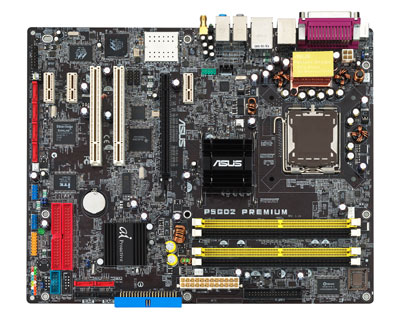 |
| Asus P5GD2 Premium - Wireless Edition |
Just like the P5AD2-E, the P5GD2 is designed on a black PCB. Even though
the designs of the two motherboards may at first look similar, there are still
a few visual differences which we'll examine later on.
Northbridge/Southbridge
The basic difference between the two motherboards lie beneath the
northbridge. The P5GD2 utilizes the Intel 915P chipset whereas the P5AG2 the
newer Intel 925XE. Both boards are equipped with the same black fanless heatsinks
covering the chipsets.
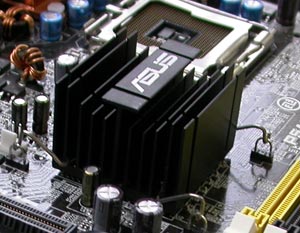 |
| Asus P5GD2 Premium Northbridge |
Both motherboards use the Intel ICH6R as their southbridge
chipset. That chipset manages the USB, serial, audio, IDE and ISA I/O.
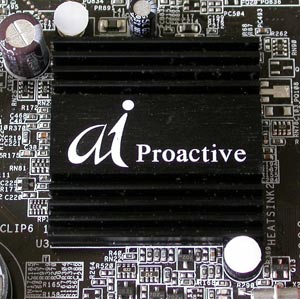 |
| Asus P5GD2 Premium Southbridge |
As part of Asus' noiseless design philosophy, the P5AG2 Premium
uses passive cooling so no fans are needed for cooling the chipset.
Packaging
The packaging for the P5GD2 is similar to all other ai Proactive boards.
The ai Proactive logo is splashed across the front of the silver and black
box.

As you open the box, you will notice one thing: the board ships
with a lot of accessories. If you forget how the contents were laid out in
the
box, you will surely have a hard time putting them back in and then closing
the box.
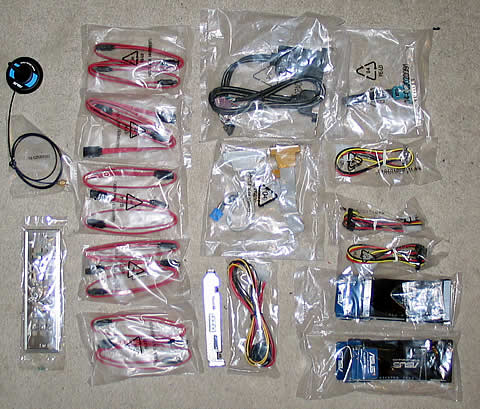
Accessories:
1 x Wireless LAN antenna (optional)
1 x 2-port IEEE1394b / 1-port RJ45 module
10 x Serial ATA cables
1 x SATA Extension module for external devices
4 x 2-port SATA power cable
1 x 2-port USB2.0 / Game module
1 x COM Port module
2 x UltraDMA 133/100/66 cable
1 x IDE cable
1 x FDD cable
1 x I/O Shield
User's manual
Software included:
InterVideo WinDVD Suite (OEM version)
Asus Drivers CD
ASUS PC Probe
ASUS LiveUpdate Utility
Anti-virus software (OEM version)
Warranty:
All Asus motherboards are covered by a 3-year warranty.
2. Features
| CPU |
- LGA775 socket for Intel Pentium 4/Celeron CPU
- Compatible with Intel 04B and 04A processors
- Intel Hyper-Threading Technology ready |
| Chipset |
Intel 925XE
Intel ICH6R |
| Front Side Bus |
800 / 533 MHz |
| Expansion Slots |
1 x PCI Express x16 slot for discrete graphics card
3 x PCI Express x1
2 x PCI |
| Storage/Raid |
IntelR ICH6R South Bridge:
*1 x UltraDMA 100/66/33
*4 x Serial ATA with IntelR Matrix Storage Technology with RAID 0, 1 support
Silicon ImageR RAID controller:
*4 x Serial ATA with JBOD, RAID 0, 1, 10, 5 (RAID 5 software patch available, no WHQL)
ITE IDE RAID controller:
* 2 x UltraDMA 133/100/66 with JBOD, RAID 0, 1, 0+1 support |
| LAN |
Dual Gigait LAN controllers
1 x Marvell PCIe 88E8053 Gigabit LAN controller
1 x Marvell PCI 88E8001 Gigabit LAN controller
features AI NET2 |
| Wireless LAN: WiFi-g |
54 Mbps IEEE 802.11g and backwards compatible with 11 Mbps 802.11b
- Access Point function (under WinXP, 2003)
- Bundle an external antenna
- One-touch wizard
- Wireless bridge, a.k.a. WDS or wireless repeater (under WinXP, 2003) |
| Audio |
- C-Media High Definition Audio 8-channel CODEC
- Coaxial, Optical S/PDIF out on back I/O port
- Features Dolby Digital Live technology |
| IEEE 1394b/a |
TI 1394b controller supports
- 2 x 1394b ports @ 800 Mbps speed
- 1 x 1394a ports @ 400 Mbps speed |
| USB |
Max. 8 USB2.0 ports |
| ASUS AI Proactive Features |
AI NOS (Non-delay Overclocking System)
AI NET2 network diagnosis before entering OS
WiFi-g powered by WiFi@HOME technology
Stack Cool patented fanless cooling system |
| Overclocking Features |
- AI NOS (Non-delay Overclocking System)
- AI Overclocking (intelligent CPU frequency tuner)
- CPU, Memory, and PCIe x16 voltage adjustable
- SFS (Stepless Frequency Selection) from 100MHz up to 400MHz at 1MHz increment
- Adjustable FSB/DDR ratio. Fixed PCI/PCIe frequencies.
- ASUS C.P.R.(CPU Parameter Recall)
|
| Other ASUS Special Features |
CrashFree BIOS 2
Q-Fan2
Post Reporter
Multi-language BIOS
MyLogo2 |
| BIOS |
8 Mb Flash ROM,AMI BIOS, PnP, DMI2.0, WfM2.0, SM BIOS 2.3 |
| Back Panel I/O Ports |
1 x Parallel
1 x WLAN antenna jack (optional)
1 x Optical + 1 x Coaxial S/PDIF Output
1 x PS/2 Keyboard
1 x PS/2 Mouse
1 x RJ45
4 x USB 2.0/1.1
1 x IEEE1394a
8-Channel Audio I/O |
| Internal I/O Connectors |
2 x USB 2.0 connectors supports additional 4 USB 2.0 ports
1 x LAN connector
2 x IEEE1394 connectors
1 x COM connector
1 x GAME/MIDI connector
CPU / 2 x Chassis / Power Fan connectors
Front panel High Definition Audio connector
Chassis Intrusion connector
CD audio-in connector
24-pin ATX Power connector
4-pin ATX 12V Power connector |
| Support CD |
Drivers
ASUS PC Probe
ASUS LiveUpdate Utility
Anti-virus software (OEM version) |
| Accessories |
InterVideoŽ WinDVD Suite (OEM version)
1 x Wireless LAN antenna (optional)
1 x 2-port IEEE1394b / 1-port RJ45 module
10 x Serial ATA cables
1 x SATA Extension module for external devices
4 x 2-port SATA power cable
1 x 2-port USB2.0 / Game module
1 x COM Port module
2 x UltraDMA 133/100/66 cable
1 x IDE cable
1 x FDD cable
1 x I/O Shield
User's manual |
| Form Factor |
ATX Form Factor, 12"x 9.6"(30.5cm x 24.5cm) |
 The
P5GD2 Premium is a total solution for the Intel 915P chipset. Create a wireless
home network, build servers and workstations with triple RAID data security
and enjoy dual-Gbit Ethernet high data throughput with this all-new motherboard.
It also supports LGA 775 CPU, dual-channel DDR 2, PCI Express x16 graphics,
Serial ATA and IEEE 1394b.
The
P5GD2 Premium is a total solution for the Intel 915P chipset. Create a wireless
home network, build servers and workstations with triple RAID data security
and enjoy dual-Gbit Ethernet high data throughput with this all-new motherboard.
It also supports LGA 775 CPU, dual-channel DDR 2, PCI Express x16 graphics,
Serial ATA and IEEE 1394b.
Some of the P5AD2-Premium's features deserve a little more attention:
 |
DDR2 711 Native Support
Although Intel's 925XE chipsets claimed to only support DDR2 400/533, ASUS engineers successfully unleashed their true potential. This model offers native DDR2 711, eliminating the bottleneck when overclocking both the CPU and memory. With current processors supporting 1066MHz FSB, ASUS motherboards, the only solutions with native DDR2 711, will provide superior performance for the most demanding applications. |
 |
Hyper Path2 - Shorten Memory Latency
The innovative ASUS Hyper Path2 significantly shortens the latency time between the CPU and memory on 925XE chipsets and improves memory performance without sacrificing stability. Enabling both Hyper Path2 and Intel PAT (Performance Acceleration Technology) on the ASUS 925XE based motherboards, delivers powerful computing never seen before. |
 |
Intel 925XE chipset
The Intel 925XE Express chipset is a new breed of Intel's state-of-the-art desktop chipsets. It supports the latest PC technologies such as LGA775 Pentium 4 CPU, dual-channel DDR2 memory architecture, and PCI Express x16 graphics card interface.
Its PAT (performance acceleration technology) function boosts the system performance without sacrificing any system stability. Companioned with the ICH6R Southbridge chip to provide integrated 4-port SATA RAID controller, PCI Express x1 interfaces and 8 high-speed USB 2.0 ports, the Intel 925XE chipset is the best solution for high-end desktop system. |
 |
Intel LGA775 Pentium 4 CPU
This motherboard supports the latest Pentium 4 CPU from Intel in LGA775 package. With 800MHz FSB, 1 MB L2 cache, Hyper-Threading Technology and core-speeds up to 3.6GHz and beyond, Intel's LGA775 Pentium 4 is one of the fastest desktop processors to date. |
 |
Intel PAT
The Intel Performance Acceleration Technology (Intel PAT) delivers additional system-level performance by optimizing memory access between CPU and system memory, and allows increased performance at standard operating specifications. |
 |
PCI Express Architecture
PCI Express is the latest I/O interconnect technology that will replace the existing PCI. With a bus bandwidth 4 times higher than that of AGP 8X interface, PCI Express x16 bus performs much better than AGP 8X in applications such as 3D gaming. PCI Express x1 also outperforms PCI interface with its exceptional high bandwidth up to 500MB/s. The high speed PCI Express interface creates new usages on desktop PCs e.g., Gigabit LAN, 1394b, and high-speed RAID systems. |
 |
Cooler Overclocking and Quieter Operation!
Heat causes instability and shortens system lifecycle, and motherboard power circuitry is a major thermal source. The patented Stack Cool™ technology utilizes a mini PCB stacked against the main PCB to conduct heat away from power components, resulting in a 10° Celsius reduction. And voila! Cooler overclocking, quieter fan operation, greater stability and longer system life without you doing a thing. |
 |
Wireless setup made affordable and easy!
WEP? SSID? Building a home WLAN used to be a hassle with confusing acronyms and cryptic menus. With WiFi-g™ and its one-touch setup wizard, high-speed wireless network is just a few clicks away. WiFi-g™ serves as the access point of your network or if you already have an access point, it is also a wireless adapter for PCs to access existing WLAN.
(WiFi-g™ compliant to IEEE 802.11g 54 Mbps data transfer) |
 |
Boost performance when you need it the most!
Applications such as 3D games and video editing demand a huge chunk of system resource.
Inject "nitrous oxide" into your CPU! The patented AI NOS™ (Non-delay Overclocking System) technology intelligently detects system load and automatically boosts performance for the most demanding tasks. Unlike other dynamic overclocking techniques, AI NOS™ reacts much faster to satisfy your unending need for speeds.
|
 |
Diagnose LAN connection before entering OS!
Network problems are often caused by bad cable connection.
AI NET2 remotely detects cable connection the second you turn on the system, and any faulty connections are reported back up to 100 meters at 1 meter accuracy. |
 |
High Definition Audio
Enjoy high-end sound system on your PC! The onboard 8-channel HD audio (High Definition Audio, previously codenamed Azalia) CODEC enables high-quality 192KHz/24-bit audio output, jack-sensing feature, retasking functions and multi-streaming technology that simultaneously sends different audio streams to different destinations. You can now talk to your partners on the headphone while playing a multi-channel network games. All of these are done on one computer. The Dolby Digital Live technology from Dolby Lab encodes the multi-channel audio source into AC-3 bit-stream and outputs it to S/PDIF port in real time. |
Stack Cool

Dual Gigabit LAN
The integrated dual Gigabit LAN design allows a PC to serve as a network bridge
for managing traffic between two separate networks. This capability ensures
rapid transfer of data from WAN to LAN without any added arbitration or latency.
No more bottleneck to handle large amounts of data such as video, audio,
and voice.
IEEE 1394b/a
1394b (FireWire 800) - with its higher bandwidth up to 800 Mbps, longer distances
and much higher-powered bus - is more suitable for bandwidth-intensive
applications like digital video (DV), professional audio, hard drives, which
often consume hundreds or even thousands of megabytes of data per file. With
backwards compatibility with 1394a, this motherboard provides 1 x 1394a and
2 x 1394b ports.
Serial ATA & IDE RAID
The onboard Silicon Image Sil3114R and ITE 8212F RAID controllers plus the Intel ICH6R southbridge provide the best solution to your RAID requirements on different storage standards. The Intel ICH6R supports RAID 0, 1 and Intel Matrix RAID Technology on 4 Serial ATA ports. The Silicon Image Sil3114R controller offers four additional SATA interfaces and allows RAID 0, 1, 10, JBOD, and a RAID software patch to support RAID 5. For IDE hard disk drives, the ITE 8212F controller provides RAID 0, 1 , 0+1 functionality for two ATA133 channels.
ASUS Q-Fan2
ASUS Q-Fan2 technology intelligently adjusts both CPU fan and chassis fan speeds according to system loading to ensure quiet, cool and efficient operation.
S/PDIF-out on Back I/O Port
This motherboard provides convenient connectivity to external home theatre
audio systems via an optical or coaxial S/PDIF-out (SONY-PHILIPS Digital
Interface) jack. It allows to transfer digital audio without converting to
analog format and keeps the best signal quality.
Max. 8 USB 2.0 ports support
USB 2.0 is the latest connectivity standard for next generation components and peripherals. Backwards compatible with current USB 1.1 peripherals, USB 2.0 delivers transfer speeds up to 40 times faster at 480Mb/s, for easy connectivity and ultra-fast data transfers.
Multi-language BIOS
The multi-language BIOS allows you to select the language of your choice from the available options. The localized BIOS setup menu helps you configure your system easier and faster.
ASUS CrashFree BIOS2
The CrashFree BIOS2 feature now includes the BIOS auto-recovery function in a support CD. Users can reboot their system through the support CD when a bootable disk is not available, and go through the simple BIOS auto-recovery process.
ASUS motherboards now enable users to enjoy this protection feature without the need to pay for an optional ROM.
C.P.R.(CPU Parameter Recall)
When the system hangs due to overclocking failure, there is no need to open the case to clear CMOS data. Just simply restart the system, the BIOS would show the previous setting and then users can amend the CPU setting again.
WinDVD Suite (On Retail Version Only)
ASUS motherboards, intensifying leadership in the IT industry, now bundle the
versatile InterVideo WinDVD Suite. This multifaceted software set includes
the latest multimedia software (OEM version), bringing forth the multimedia
features of ASUS motherboards to the best!
3. Board Layout
CPU Socket
In the socket 775 architecture, the pins have moved from the processor and
onto the motherboard socket. This way, breaking one of the pins no longer results
in a destroyed processor but a destroyed motherboard, which is easier and cheaper
to replace.
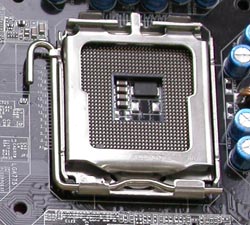
Memory Banks
The mainboard supports Symmetric and Asymmetric Dual Channel mode and of course Single Channel access to the memory. Asymmetric Dual Channel mode is activated when two opposite channels (two yellow or two black) are populated by different capacity memories. However even Intel has admitted it offers no performance increase over Single Channel mode.

Back Panel
The rear panel input/output provides the following connections:
From left to right and top to bottom:
- parallel connection
- the mouse PS/2 female connection
- the keyboard connection
- two SPDIF ports
- one firewire IEEE 1394a and two USB 2.0 ports
- one gigabyte lan port and two USB 2.0
- Rear/Side/Center Speaker Out
- Line In/Line Out/Mic In
- Wireless LAN led and Antenna connection

One thing to notice here is the lack of a serial COM port. However,
if you are really in need of such a port, you can construct it yourself using
a serial COM cable from an older computer and connecting it on the available
pins located at the southeast corner of the motherboard.
Drive Connectors
The P5GD2 motherboard features 3 connectors for IDE and 8 for
Serial ATA drives. The primary connector is coloured blue and is located on
the edge of the motherboard.
As with the P5AD2-E, there's no distinct secondary controller on the motherboard.
Instead the RAID controller should be used to install any extra devices..
The RAID controller consists of two red connectors which can be seen in the picture below and can be
set up to form RAID 0, RAID 1 and RAID 0+1 disk arrays or even be used as a secondary IDE.

The SATA connectors are divided into two sets of four. The first
set is controlled by a Silicon Image chip and supports RAID 0, RAID 1, RAID
10 and software RAID 5.

The second set, being controlled by the ICH6 chipset on the southbridge,
is only capable of supporting RAID 0 and RAID 1 disk arrays.

Slots
Here's another point where the P5GD2 differs from the P5AD2-E.
The P5GD2 has one more PCI-Express x1 slot located in the strangest position
just above the x16 PCI-E, but one less regular PCI slot.

As currently there are no PCI-E x1 compatible hardware on the
market, having only two PCI slots might seem a problem. However, as the P5GD2
is a very rich
in features
motherboard, it is very unlikely you'll need to use a third slot.
4. 3DMark03
 3D Mark is a widely used and accepted benchmark that stresses the DirectX performance of a VGA card. A very strong point of 3DMark is that it's VGA card measuring is does not require any CPU power. So the resulting fps are a good reference a VGA card's rendering performance. For testing the performance of each card we used the 4 game benchmarks 3DMark has.
3D Mark is a widely used and accepted benchmark that stresses the DirectX performance of a VGA card. A very strong point of 3DMark is that it's VGA card measuring is does not require any CPU power. So the resulting fps are a good reference a VGA card's rendering performance. For testing the performance of each card we used the 4 game benchmarks 3DMark has.
3Dmark03 also includes sound and CPU tests as well as some other feature tests.
- Game Test 1 - Wings of Fury (DX7)

This test is a combat flight simulator written for older hardware (DirectX 7). Particles are used a lot in this test - smoke and vapor trails, flak and gunfire, and explosions are produced using point sprites and quads.
- Game Test 2 - Battle of Proxycon (DX8)

This test is a simulation of first person shooter game types. 1.1 and 1.4 Vertex shaders are widely used since all character models are skinned using vertex shaders.This makes this test a good vertex shader comparison for VGA cards.
- Game Test 3 - Trolls' Lair (DX8)

This test should be the favorite of all RPG lovers. It is a cut scene of a female warrior facing two malicious trolls. Again the same vertex and pixel processing is used as in game test 2.
This test also uses post-processing effects, such as Depth of Field and Bloom effects which are widely used in today's game cut scene sequences.
- Game Test 4 - Mother Nature (DX9)

Mother nature represents the level of effects and realism that are possible using 2.0 vertex and pixel shaders, plus some other features that DirectX 9 offers.
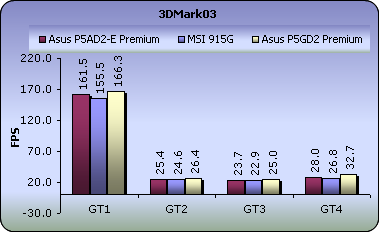
In the first game test where the fps are much higher than the
rest, you have a clearer view of the rankings. However, in all the game
tests, the P5GD2 seems to outshine the two other motherboards, bringing
the best out of our Powercolor X600XT.
- 3DMark Official score
If you test your machine with 3DMark, you can post the results
at 3DMark's online result browser. For more information visit futuremark.com.
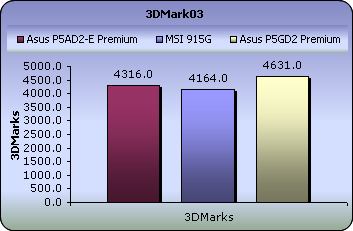
The final scores for 3DMark03 are a good example of the importance
of choosing the right motherboard. With the Asus P5GD2 Premium we were able
to achieve 500 more 3dmarks than with MSI's 915G which is a little
more than a 10% difference.
5. Performance Part 2
PCMark04
PCMark04 is an application-based benchmark and a premium tool for measuring overall PC performance. It uses portions of real applications instead of including very large applications or using specifically created code. This allows PCMark04 to be a smaller installation as well as to report very accurate results. You may download a shareware version of PCMark04 from Futuremark.
| |
P4 3GHz
w/ MSI 915G |
P4 3GHz
w/ Asus P5AD2-E Premium |
P4 3GHz
w/ Asus P5GD2 Premium |
PCMarks |
3949 |
4586 |
4787 |
File Compression |
4.1 MB/s |
4.1 MB/s |
4.5 MB/s |
File Encryption |
55.0 MB/s |
55.9 MB/s |
56.8 MB/s |
File Decompression |
35.9 MB/s |
35.4 MB/s |
36.3 MB/s |
Image Processing |
14.6 MPixels/s |
14.5 MPixels/s |
15.0 MPixels/s |
Virus Scanning |
2576.2 MB/s |
2451.5 MB/s |
3234 MB/s |
Grammar Check |
2.1 KB/s |
2.1 KB/s |
2.2 KB/s |
File Decryption |
85.7 MB/s |
86.3 MB/s |
86.6 MB/s |
Audio Conversion |
2340.6 KB/s |
2353.1 KB/s |
2361.1 KB/s |
Web Page Rendering |
5.3 Pages/s |
5.1 Pages/s |
5.5 Pages/s |
WMV Video Compression |
51.3 FPS |
52.2 FPS |
51.6 FPS |
DivX Video Compression |
65.6 FPS |
67.9 FPS |
68.4 FPS |
Physics Calculation and 3D |
80.6 FPS |
164.4 FPS |
169.6 FPS |
Graphics Memory - 64 lines |
680.5 FPS |
2313.8 FPS |
2313.1 FPS |
The older 915P managed to bring the best out of our 3.0GHz Intel processor. WMV Video Compression was the only part of the PCMark04 System Test Suite where it was outperformed by the 925XE of P5AD2-E. All the other tests show significant differences.
3DMark01
You may download a shareware version of 3DMark 2001 from Futuremark.
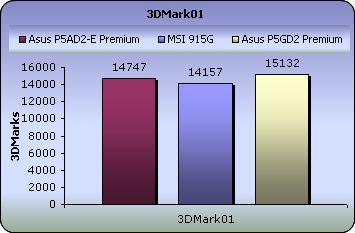
In 3DMark01 the P5GD2 scored 15132 marks, 400 more than the
P5AD2-E and 1000 more than the MSI 915G motherboards.
Aquamark03
Aquamark03 is available for download from Aquamark's official website.

In Aquamark3, the Asus mainboards seem to be equally powerful,
and certainly more so when compared to the 915G from MSI which offers 8%
lower performance.
6. Half Life 2
Half life 2 is no doubt the most anticipated pc game of all times. Gamers keeping the excellence of Half Life 1 in their mind as well as the remarkable E3 demo preview, have been anxiously waiting for the much delayed release of HL2.
Regarding the storyline, the player again picks up the crowbar of research scientist Gordon Freeman, who finds himself on an alien-infested Earth being picked to the bone, its resources depleted, its populace dwindling. Freeman is thrust into the unenviable role of rescuing the world from the wrong he unleashed back at Black Mesa. And a lot of people he cares about are counting on him.



To measure performance we used the Video Stress Test(VST) that is available in the CounterStrike:Source beta available through Steam. We set all the details to the highest level and each time changed the resolution from 800x600 up to 1600x1200.

In the Half Life 2 Video Stress Test, we see no difference
between the two Asus boards. However the MSI's motherboard
is left trailing behind its
competitors with framerate differences ranging from 5 to 14 fps.
7. Ground Control II
 Ground
Control 2 is an action-oriented game of tactics and warfare. As Captain Jacob
Angelus of the Northern Star Alliance, you will command squads of infantry,
artillery, and airpower against the might of the Empire of Terra. Base building
and resource-collecting
are replaced with unit control and combat tactics where your knowledge of the
battlefield maneuvers will make the difference in your fight against a ruthless
enemy. Position your troops on hilltops for better aim or inside buildings and
forests for protection as you'll need to use every inch of terrain to your advantage.
Call in air strikes or assault pods to bring the battle behind enemy lines.
Send out scouts to locate the enemy and use spotters for your artillery with
the 360° free-roaming camera. Experience the total immersion of futuristic
warfare as you lead your forces to victory!
Ground
Control 2 is an action-oriented game of tactics and warfare. As Captain Jacob
Angelus of the Northern Star Alliance, you will command squads of infantry,
artillery, and airpower against the might of the Empire of Terra. Base building
and resource-collecting
are replaced with unit control and combat tactics where your knowledge of the
battlefield maneuvers will make the difference in your fight against a ruthless
enemy. Position your troops on hilltops for better aim or inside buildings and
forests for protection as you'll need to use every inch of terrain to your advantage.
Call in air strikes or assault pods to bring the battle behind enemy lines.
Send out scouts to locate the enemy and use spotters for your artillery with
the 360° free-roaming camera. Experience the total immersion of futuristic
warfare as you lead your forces to victory!
For our benchmarks, we used the highest possible settings on the first mission
of the single player game.

Ground Control II offers really impressive graphics without requiring much GPU power. Click on the picture above to view a screenshot from the game. Check out these excellent water effects!
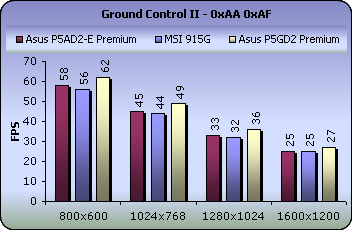
Ground control being a strategy game is quite dependent on the
CPU and motherboard performance. Once more here, the P5GD2 leads the race with
the P5AD2-E following and last trying to catch up, is the 915G from MSI.

8. Bios & Overclocking
As with all the latest and feature-rich motherboards, so too
the P5GD2 has an option in the BIOS where you can enable or disable
all the intergrated
peripherals. HD-Audio, Firewire, Gigabit Lan and the WiFi controller can
all be disabled so that they don't even get detected by the operating
system. Disabling the RAID controller is strongly suggested if you don't
need it,
as it takes up quite some time during boot scanning checking for available
RAID configurations.
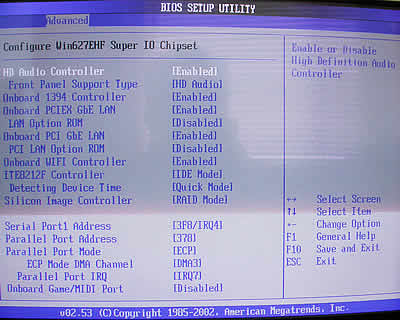
Overclocking is really easy with the Asus P5GD2 from the Advanced
tab menu in the BIOS. AI Overclocking powers this Asus motherboard
too, with the options you can see in the picture below.
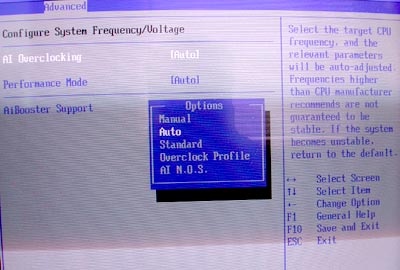
As soon as you set the "N.O.S." value to the AI Overclocking
option, there's nothing else to worry about. The next time the system boots
into the
operating system and the chipset detects heavy CPU load, it will automatically
adjust the FSB clock and CPU core voltage and overclock your processor.
N.O.S. is quite a safe overclocking method as it tends to clock the processor
only a little higher than it's stock clock frequency.
We used N.O.S to overclock our P4 3.0GHz processor. When idling,
the processor settings are the following as detected by CPU-Z:

However, when running an application that required a little
more CPU power, N.O.S. was activated and we had the following:

Apart from N.O.S. Asus offers another easy way of overclocking
the CPU. Choosing for "Overclocking Profile" the "Overclock
30%" option, our Intel 3.0GHz is automatically clocked to 3.9GHz at
all times :

As you can see, the FSB speed was boosted up to 260MHz and
consequently, the Bus Speed reached 1040MHz.
Both N.O.S. and Overclocking profiles are excellent choices for the average computer user since they don't require much knowledge to use them. Voltage settings, memory speeds and everything else is taken care off by the BIOS.

In the picture above you can see the BIOS setting allowing you to choose whether the RAID controller should be used as a Standard IDE controller or RAID 0/1/0+1.
Just like the P5AD2-E, apart from automatic overclocking the
P5GD2 allows you to manually overclock the processor with a large variety
of settings to mess with, if you have the time and knowledge for it.
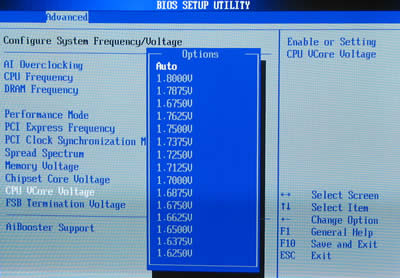



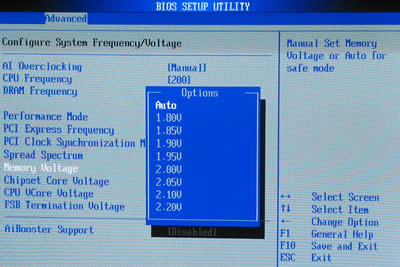
9. Bundled Software
The included CD-ROM, apart from the drivers, also contains some
applications and other software:

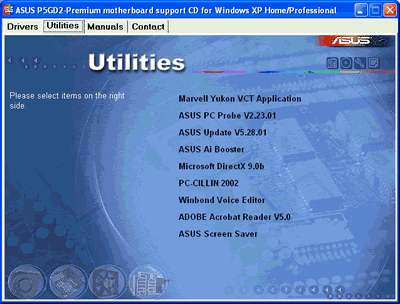

- PC Probe utility
ASUS PC Probe is a very simple utility that monitors vital information in
the computer such as fan rototation speed, voltages and temperature. It also
gives system information about hard disk space, memory usage, CPU type and
processor
speed. It resides in the taskbar and provides audio warnings (through the PC
speakers) if certain thresholds such as temperature and voltage have been exceeded.
If your system is overclocked, remember to raise the appropriate warning limits
or face frequent warning pop-ups.




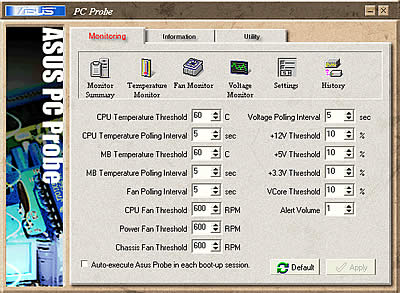

- Asus Update utility
This is also a very simple utility for updating the BIOS on your board with
the options presented below.


10. Conclusion
The P5GD2 is another full-featured motherboard by Asus. Everything you'll ever ask for in a motherboard is already supported and included inside the packaging. Wireless LAN, PCI-Express, Gigabit LAN, HD-AUDIO,
SATA/IDE RAID, Dual Channel, N.O.S. are only some of the board's long list of features.

To measure the performance of the P5GD2, we ran a series of
tests covering both 2D and 3D applications. The motherboard managed to pleasantly
surprise us as it outperformed both of its contestants in all of our benchmarks
by
usually large differences, especially in PCMark04 and 3DMark01.
Just when we thought overclocking was easy with the P5AD2-E,
Asus surprised us with the overclocking available on the P5GD2. With just
the press of a button in the BIOS, our P4 3.0GHz was successfully turned
into a P4
3.9GHz system.
We
didn't
have to mess with any voltage settings or even clock frequencies!

The motherboard costs approximately US$180. Consider the
money you might have spent on a Wireless card, HD audio card or some other
extra component. Add to that the performance of the motherboard and all its
features, be it hardware or even BIOS based and you have a winner motherboard,
totally worth its money.

Pros:
- Full-featured at the right cost
- Excellent performance
- Easy yet high overclocking
Cons:
- Only 2 PCI slots
| Features |
|
| Performance |
|
| BIOS/Overclocking |
|
Value for money |
|